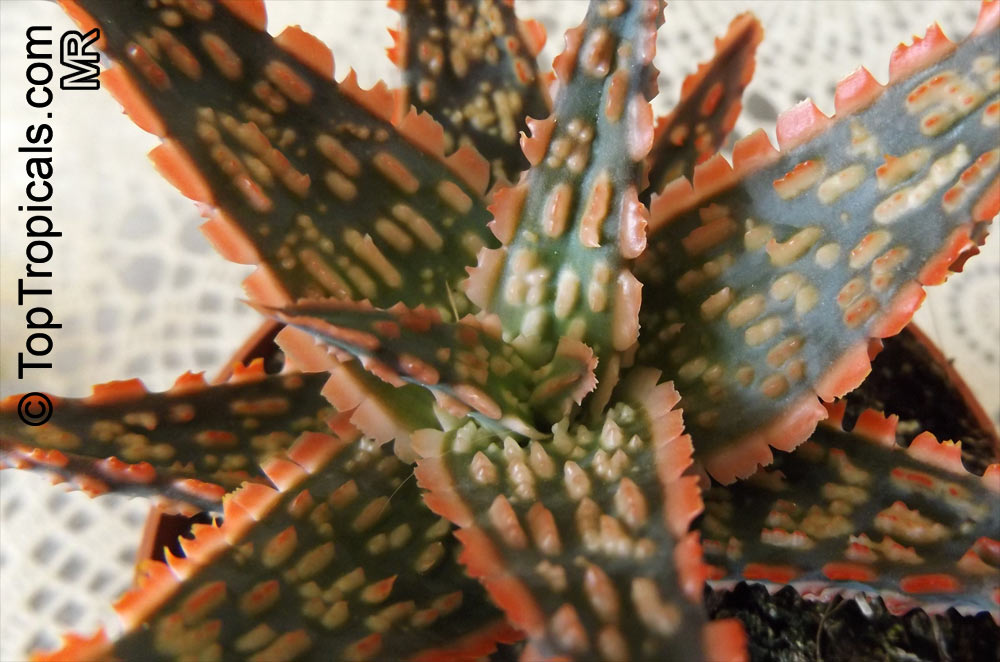Aloe barbadensis, Aloe Vito Kamikaze
7020 Aloe barbadensis, Aloe Vito Kamikaze














This rare cultivar was created by Kelly Griffin, an American hybridizer, and is sometimes referred to as Kamikaze in certain sources.
Recommended Fertilizer: SUNSHINE Robusta - Rapid Growth Booster
Aloe barbadensis, Aloe Vito Kamikaze: Planting and Care Instructions
Plant Overview
Growth habit: This is a small herbaceous plant, growing between 2 and 5 feet. It is great for flower beds, pots, or small garden spots.
Growing conditions: This plant can be grown outdoors in suitable USDA zones. It is well-suited for small backyards, pots, or indoor spaces with enough light.
Watering: This plant prefers dry to moderately moist soil. Water it occasionally, letting the soil dry out between waterings.
Sun exposure: This plant grows well in both full sun and semi-shade. If kept indoors, give it as much light as possible for best growth.
USDA Zone: USDA 9-11. The USDA Plant Hardiness Zone Map categorizes North America into zones based on average annual minimum winter temperatures, each differing by 10 °F. This map serves as a basic guide for selecting appropriate plants for a region. However, it's not definitive; plant varieties vary in cold tolerance, and young plants typically need more protection. Additionally, local microclimates, like sheltered areas or sunny spots, can influence plant health and survivability beyond the general zone recommendation.
Hardiness: Tolerates light freezing to about 30°F for short periods (mature plants). Young plants must be protected. Plant hardiness indicates the coldest temperature a mature plant can endure briefly while staying healthy. This rating is a guideline and can vary among varieties of the same species. Young plants often need more cold protection. Additionally, a plant's survival can be enhanced by the microclimate of its location, which may provide shelter from wind or extra warmth, allowing it to thrive beyond its typical hardiness range.
Flower color: This plant produces pink, white and off-white, red, crimson, or vinous, and yellow or orange flowers during its blooming season.
Foliage: This plant is grown for its ornamental foliage, which adds texture or color to the landscape even when not in bloom.
Butterfly attractor: This plant attracts butterflies and hummingbirds, making it a great choice for pollinator-friendly gardens.
Thorns: This is a thorny or spiny plant. Use gloves when handling or placing it in the garden.
Ethnomedicinal: This plant has ethnomedical uses and has been traditionally valued in folk or indigenous medicine. Plants marked as ethnomedical and/or described as medicinal are not offered as medicine but rather as ornamentals or plant collectibles. Ethnomedical statements or products have not been evaluated by the FDA and are not intended to diagnose, treat, cure, or prevent any disease. All customers should consult a physician before using any supplements, herbals, or medicines.
Outdoor planting
Select a planting spot that fits the plant sun and moisture needs. Loosen the soil and mix in compost or organic matter to improve poor soil. Dig a hole just slightly larger than the root ball and avoid planting deeper than it was before. For better drainage, the top of the root ball can sit slightly above the surrounding soil. Provide temporary shade at first if conditions are hot or sunny. Water regularly and monitor soil moisture until the plant is well rooted. nAdd mulch around the base to keep the soil moist and reduce weeds. Shape the mulch to form a shallow basin for water, but keep mulch away from the stem.
Indoor planting
Use a container with drainage holes and a well-draining potting mix. Position the plant so that the top of the root ball is level with the surface of the soil - avoid planting too deep. A slow-release fertilizer can be mixed into the soil at planting time to support healthy growth. Place the plant in a location that matches its light needs, and water according to its care requirements. Be careful not to overwater, and ensure good airflow around the plant to reduce the risk of pests and disease.
Protecting Plants in Winter
When it gets cold, some plants need extra help. You can move potted plants indoors or under a covered patio. Young plants need extra protection because they are more sensitive to cold and less established. For plants in the ground, use frost cloth to keep them warm. Stop using fertilizer in late fall so plants can rest. Try to place plants in areas protected from cold wind, rain, and frost.
Cold Hardiness and Microclimates
USDA zone and hardiness are only general guidelines. Actual cold tolerance can vary based on plant variety and local conditions. Even small differences between varieties can matter. Also, warmer spots in your yard—like near a wall or fence—can help plants survive cold nights. These little warm areas are called microclimates, and they make a big difference.
